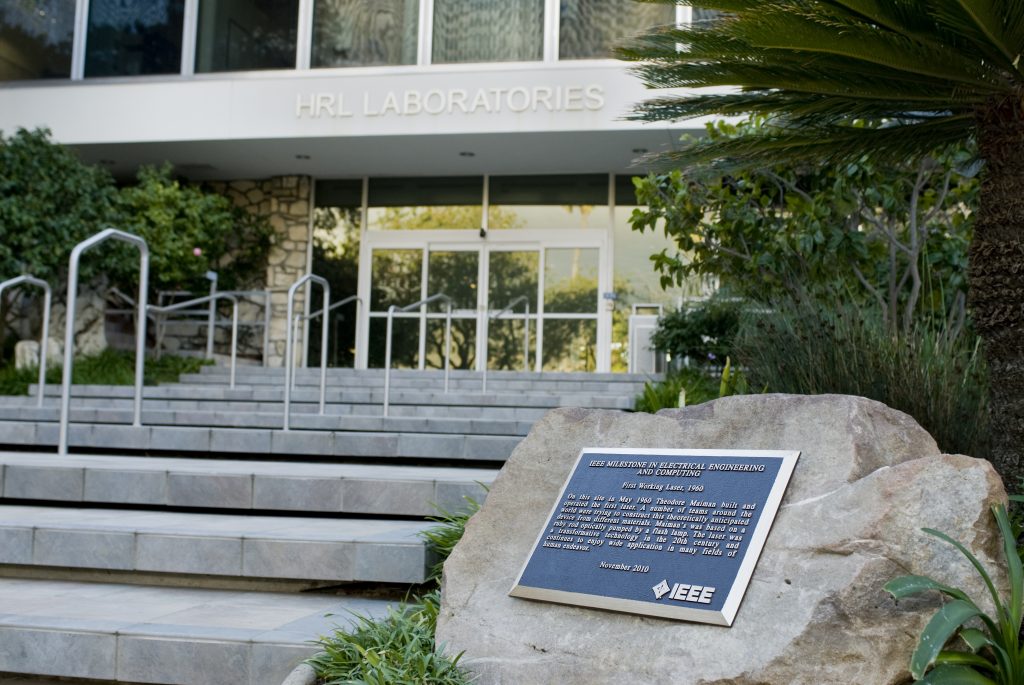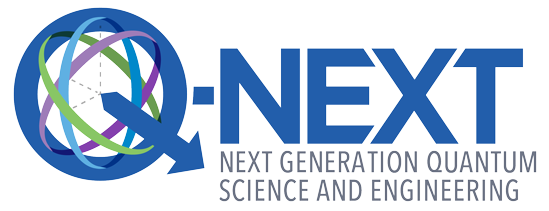In 1960, Hughes Research Laboratories demonstrated the world’s first laser, winning the global race to build the new technology. For years, major research companies had been pursuing the realization of a functioning laser, and Hughes scientist Theodore Maiman was the first to succeed, building and operating one that used a synthetic ruby crystal. It was a breakthrough born of the laboratory’s cutting-edge capabilities in photonics and materials science.
Over the last decade, the Malibu-based research lab — now named HRL Laboratories — has been applying those same capabilities to quantum information science (QIS). A Q-NEXT industry partner, HRL is helping the center develop the technologies needed to realize quantum communication.
“HRL has been an indispensable collaborator in Q-NEXT, contributing its world-class science expertise, experimental facilities and manufacturing resources to enable a future quantum communication network,” said Q-NEXT Director David Awschalom.
While QIS is only one branch of HRL research, the company’s diverse research portfolio means it can draw on a wide range of expertise to advance quantum sensing, computing and communication. HRL’s 700 employees work in high-speed electronics, advanced packaging, infrared technologies, advanced materials, machine learning, information science, cybersecurity and other areas.

HRL and the Q-NEXT mission
HRL supports the Q-NEXT mission in three research areas and a key strategic initiative:
Simulations and systems. HRL is using simulation to help define the metrics and goals for future quantum networks. Partnering with Argonne National Laboratory scientists, HRL researchers adapted an Argonne code package called SeQUeNCe. SeQUeNCe performs network simulations at the level of individual photons and integrates accurate models of optical components, enabling scientists to study their complex interactions.
Extreme-scale characterization. HRL researchers are investigating silicon carbide and other materials for use in quantum devices. In particular, they’re exploring the use of defects in silicon carbide crystals to create qubits; the fabrication of silicon carbide thin films to help shuttle photons in and out of various structures; and the use of silicon carbide and other materials to convert one type of quantum optical signal into another.
“The largest area — the area where we have the most publications and the largest team — is in the development of spin qubits in silicon,” said HRL Chief Scientific Officer David Chow. “We hope it will become the underpinning technology for a practical quantum computer in the future.”
The company’s silicon carbide R&D builds on its extensive work engineering and manufacturing the material for other uses. For example, HRL has developed silicon carbide for microelectromechanical systems such as gyroscopes and as a growth medium for semiconductors.
Quantum communication. For decades, HRL has carried out forefront photonics research for defense, telecommunication, and computing, among other areas. In recent years, it’s wielded its photonics capabilities for quantum communication.
Researchers have shown that defect centers in silicon carbide couple well with photons. They’ve also demonstrated that silicon carbide qubits can maintain information for relatively long stretches of time, a requirement for viable quantum memories and repeaters.
“Silicon carbide could be a strong photonic platform: It has so many possibilities for providing everything you need in a quantum repeater, which is going to help quantum communication go faster or over longer distances,” said HRL principal scientist Thaddeus Ladd, co-design engineer for the Q-NEXT Communication Thrust.
Quantum technology roadmapping. HRL is collaborating in the development of Q-NEXT’s quantum technology roadmap, which will chart a path to bring technologies for distributing quantum entanglement to the public in 10 to 15 years. One of three group leads for the project, HRL’s Thaddeus Ladd works with a team of Q-NEXT members to chart a course for realizing quantum communication technologies. (The other two groups focus on quantum sensing and quantum computing.)
“HRL has been instrumental in the roadmap effort, which we expect will have an impact beyond Q-NEXT, informing the direction of research taken by the broader QIS community,” Awschalom said.

Agile research
HRL’s mission is to provide a competitive advantage to its owners — Boeing and General Motors — and the U.S. government, whose contracts with the company provide a large portion of HRL’s funding.
“The thinking is that our technologies, the work we do in physical science and engineering, could lead to better products for automobiles, commercial aircraft and U.S. government defense systems,” Chow said. “Our mission is innovation-oriented rather than dollar-oriented.”
HRL’s rich body of research for the aerospace, automotive and defense sectors has been fertile soil for QIS R&D. For instance, one of the drivers of HRL’s chip-scale photonics work is the development of lidar technology — used for obstacle detection in autonomous vehicles — for Boeing and GM. Researchers are able to build on the resulting advances to design photonics for QIS.
“If you want to use laser sensing in a self-driving car, you’re going to want to put all the optics of that system in an easily manufacturable chip. That’s one way a company like HRL gets its expertise and interest in photonics,” Ladd said. “For quantum, we’re developing optical technologies in a way that is consistent with scalable photonics.”
While HRL occupies the same quantum-research milieu as larger tech companies, its research-focused mission and its size — 700 employees, 500 of whom are technical staff — allow the organization to be comparatively nimble.
“We’re a little more agile and flexible because we’re smaller,” Chow said.
The multidisciplinarity of HRL research also encourages exploration and cross-field collaboration.
“We work in a great many fields. One benefit of that is that it’s a great place for those who have side interests,” Chow said. “This is a place where you can explore those interests in addition to your interest quantum technologies.”
He continued, “We’re happy to be part of Q-NEXT, to collaborate with other organizations across the country and help build a quantum economy from which everyone can benefit.”
